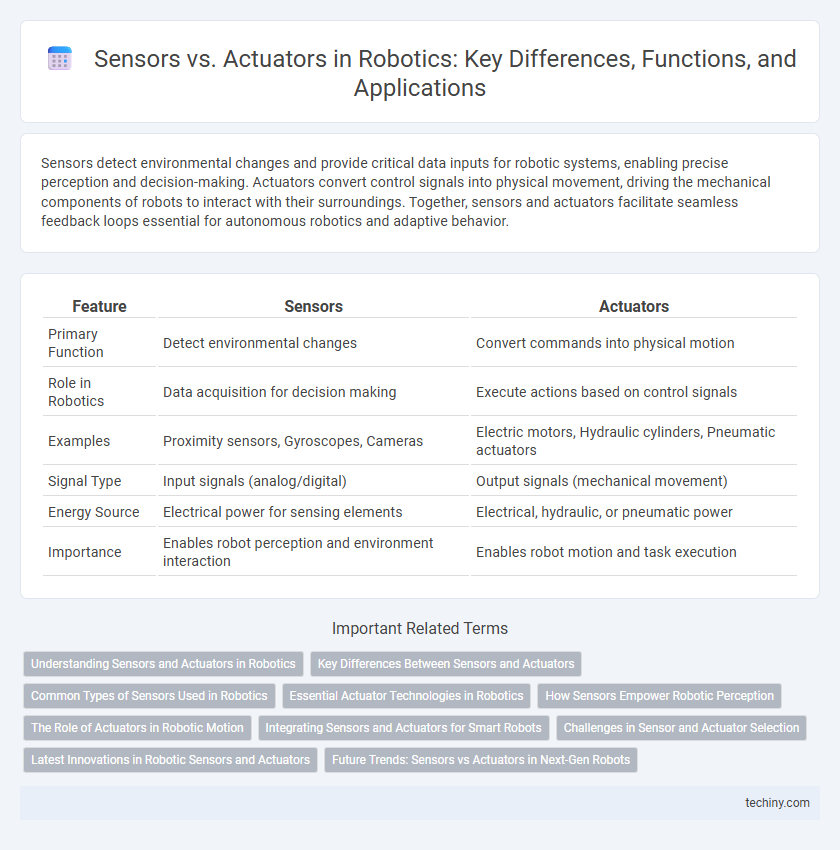Sensors detect environmental changes and provide critical data inputs for robotic systems, enabling precise perception and decision-making. Actuators convert control signals into physical movement, driving the mechanical components of robots to interact with their surroundings. Together, sensors and actuators facilitate seamless feedback loops essential for autonomous robotics and adaptive behavior.
Table of Comparison
| Feature | Sensors | Actuators |
|---|---|---|
| Primary Function | Detect environmental changes | Convert commands into physical motion |
| Role in Robotics | Data acquisition for decision making | Execute actions based on control signals |
| Examples | Proximity sensors, Gyroscopes, Cameras | Electric motors, Hydraulic cylinders, Pneumatic actuators |
| Signal Type | Input signals (analog/digital) | Output signals (mechanical movement) |
| Energy Source | Electrical power for sensing elements | Electrical, hydraulic, or pneumatic power |
| Importance | Enables robot perception and environment interaction | Enables robot motion and task execution |
Understanding Sensors and Actuators in Robotics
Sensors in robotics gather real-time data from the environment, converting physical phenomena like temperature, light, or pressure into digital signals for processing. Actuators then translate control signals from the robot's processor into physical actions such as movement or manipulation, using motors, hydraulic systems, or pneumatics. Understanding the integration of sensors and actuators is crucial for designing responsive and adaptive robotic systems capable of interacting effectively with their surroundings.
Key Differences Between Sensors and Actuators
Sensors detect and measure physical properties like temperature, pressure, and motion, converting these inputs into electrical signals for robotic systems. Actuators receive control signals and convert them into mechanical movement or action, such as motors driving wheels or robotic arms. The key difference lies in sensors providing feedback from the environment, while actuators execute commands to interact physically with the environment.
Common Types of Sensors Used in Robotics
Common types of sensors used in robotics include ultrasonic sensors for distance measurement, infrared sensors for object detection, and accelerometers for motion sensing. Cameras and LIDAR systems provide critical visual and environmental mapping capabilities, enabling robots to navigate complex spaces. Force sensors and tactile sensors allow robots to interact safely and accurately with objects by detecting pressure and touch.
Essential Actuator Technologies in Robotics
Essential actuator technologies in robotics include electric motors, hydraulic actuators, and pneumatic actuators, each providing precise control of movement and force. Electric motors, such as servo and stepper motors, offer high accuracy and speed for robotic joints and end-effectors. Hydraulic actuators deliver strong, smooth power ideal for heavy-duty tasks, while pneumatic actuators excel in lightweight, fast, and compliant motion applications.
How Sensors Empower Robotic Perception
Sensors empower robotic perception by continuously collecting accurate environmental data through technologies such as LiDAR, ultrasonic, and infrared sensors. These sensory inputs enable real-time obstacle detection, object recognition, and spatial awareness, enhancing decision-making algorithms and autonomous navigation. High-precision sensor integration improves a robot's ability to adapt to complex and dynamic environments for tasks ranging from industrial automation to autonomous vehicles.
The Role of Actuators in Robotic Motion
Actuators are critical components in robotic motion, converting electrical signals into mechanical movement that enables precise control of robot limbs and joints. Unlike sensors, which gather environmental data and provide feedback, actuators execute commands to achieve desired positions, velocities, and forces. High-performance actuators such as electric motors, hydraulic cylinders, and pneumatic systems determine the robot's agility and accuracy in complex tasks.
Integrating Sensors and Actuators for Smart Robots
Integrating sensors and actuators in smart robots enhances real-time environmental interaction, enabling precise motion control and adaptive responses. High-resolution sensors collect critical data such as proximity, temperature, and force, which actuators convert into mechanical actions like movement or gripping. Seamless communication between these components drives advanced functionalities in autonomous navigation, object manipulation, and environment monitoring.
Challenges in Sensor and Actuator Selection
Selecting sensors and actuators in robotics involves challenges such as compatibility with the robot's control system and the environmental conditions where the robot operates. Precision, response time, and power consumption must match application-specific requirements to ensure accurate sensory data and effective actuation. Trade-offs between cost, size, and robustness often complicate the decision-making process, impacting overall system performance and reliability.
Latest Innovations in Robotic Sensors and Actuators
Latest innovations in robotic sensors feature advancements in tactile sensing, enabling robots to detect pressure, texture, and temperature with unprecedented precision, enhancing interaction with complex environments. Actuators now incorporate soft robotics technology and artificial muscles, providing smoother, more flexible and energy-efficient motion control for robots across diverse applications. Integration of AI-driven sensor fusion and adaptive actuator control algorithms further optimizes robotic performance in dynamic and unstructured settings.
Future Trends: Sensors vs Actuators in Next-Gen Robots
Next-gen robots will increasingly integrate advanced sensors with high-resolution capabilities and low energy consumption, enabling real-time environmental awareness and adaptive responses. Actuators will evolve toward enhanced precision, speed, and energy efficiency, driven by innovations in smart materials and micro-electromechanical systems (MEMS). The synergy between intelligent sensors and actuators promises breakthroughs in autonomy, dexterity, and human-robot interaction.
Sensors vs Actuators Infographic

 techiny.com
techiny.com